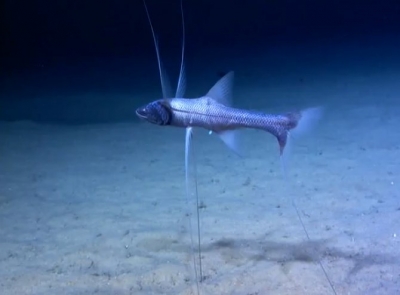
The Tripod fish or the ‘stilt walker’ has modified pelvic and caudal fins that are elongated at the tips, called rays or elements. It uses these rays to perch on the deep sea floor. Scientists suspect that fluid is: pumped through the extremely long rays, making them rigid and allowing the fish to balance while “standing”. As a result of living in virtually complete darkness, these eyeless fish have developed long pectoral fins that extend upward like antennae, and serve as tactile organs or hands, when it searches for food.
Tripod fish positions its body upstream, toward the water current and waits for the prey to come. Main purpose of elongated structures is to lift the fish from the ocean floor where water current doesn’t exist. This tactic ensures preservation of energy (tripod fish doesn’t move when hunts) and continual supplying with the prey (which ocean current brings).
Tripod fish possesses long, feathery pectoral fins that are used as tactile organ. They float in front of the fish and detect movement of the water and potential prey. When edible prey is detected, tripod fish catches it and transports it directly into the mouth (these fins are also used as hands).
Picture Credit : Google




